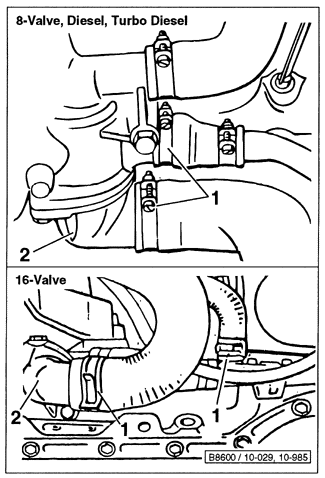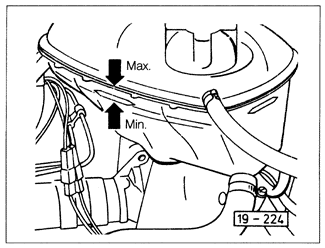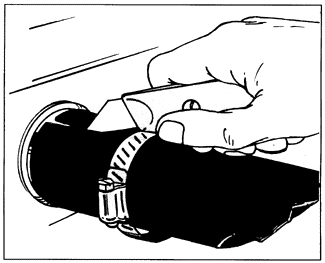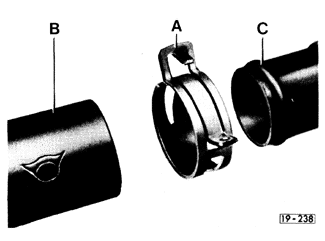Draining and Filling Coolant
To drain the coolant, disconnect the coolant hoses indicated in Fig. 4-1. To refill the system, first reinstall the lower radiator hoses and their clamps. Then fill the system with the coolant and water mixture until the level reaches the Max mark on the coolant reservoir as shown in Fig. 4-2. Mixture proportions are given in Table b. Start the engine and let it idle, rechecking the coolant level after it has had a chance to circulate. After the engine has cooled, check the coolant level and add coolant as necessary.
| Fig. 4-1. | Hoses (1) to be removed for draining coolant from coolant pump and thermostat housing (2). |

|
| Fig. 4-2. | Fill level marks on coolant expansion tank. Level should be between Max and Min marks (arrow) with engine cold. |

|
Table b. Anti-Freeze-to-Water Proportions

To replace a hose:
| 1. | Drain the coolant as described above. |
| 2. | Remove the hose. Using a screwdriver, or pliers in the case of spring clamps, loosen each hose clamp and slide the clamps away from the hose ends. |
NOTE-
If a radiator hose is stuck to the radiator connection by sealer, cut the old hose off the connection, as shown in Fig. 4-3. Prying the hose loose may damage the connection or the radiator.
|
| Fig. 4-3. | Stuck hose being removed by cutting. |

|
| 3. | Clean the hose connections. Make sure any bits of old hose and sealer are removed. Clean them with a wire brush if necessary. |
| 4. | Install the new hose. Lightly coat the connections with water-resistant sealer. Place the loose hose clamps onto the new hose before fitting the hose ends to the connections. |
NOTE-
Spring clamps should be used only with hoses and connections designed for their use. See Fig. 4-4.
|
| Fig. 4-4. | Identification of hose and connection suitable for use with spring clamp (A). Hose (B) bears spring clamp symbol and is smooth on inside (instead of corrugated). Connection (C) has larger bead and is about 5 mm (1/4 in.) longer. |

|
| 5. | Position and tighten the clamps. Place the clamp as near the bead as possible and at least 4 mm (5/32 in.) from the hose end, as shown in Fig. 4-5. Tighten screw-type clamps enough to compress the hose firmly around the connections. |
| Fig. 4-5. | Hose clamp correctly installed on hose end. |

|
CAUTION-
Do not overtighten clamps. Tighten just enough to seal. Overtightening may cause hose damage and failure.
|
| 6. | Refill the radiator as described in Draining and Filling Coolant. Run the engine until warm and check for leaks. Check again after the engine has cooled. |
|





